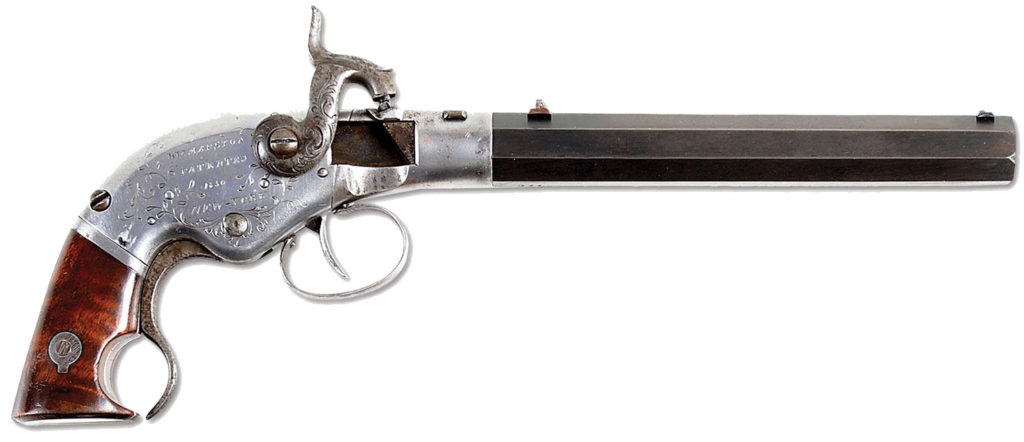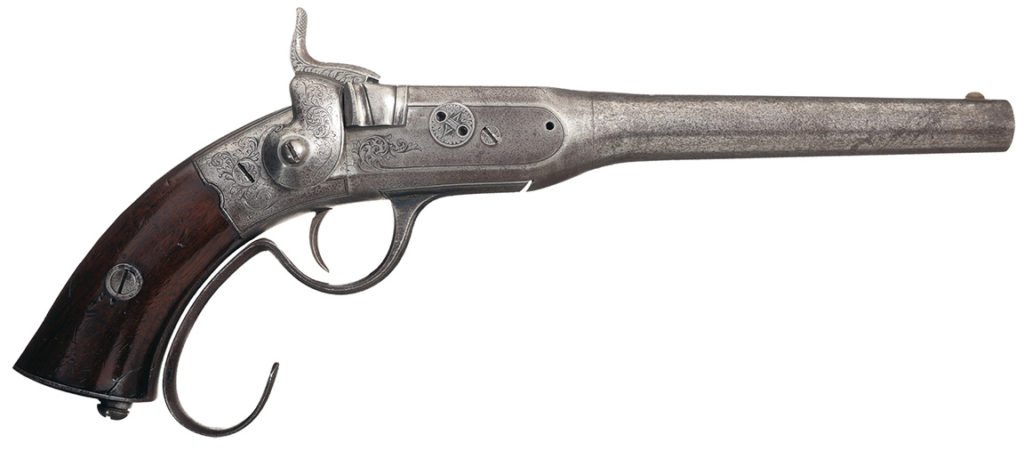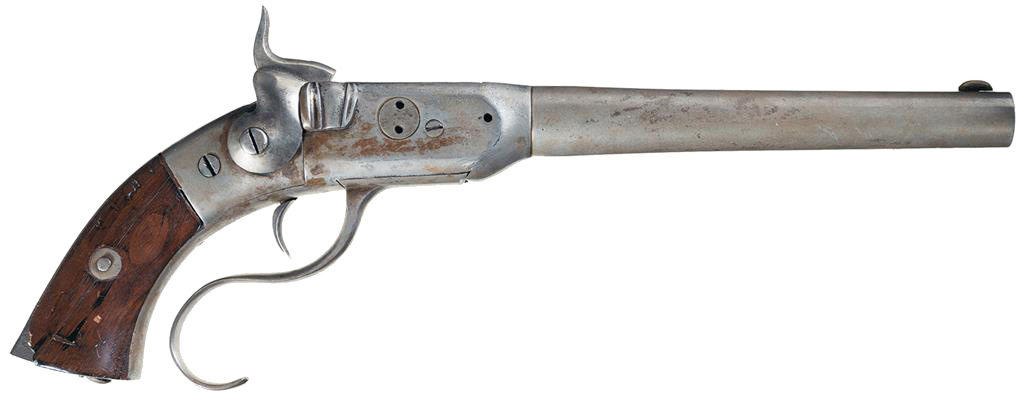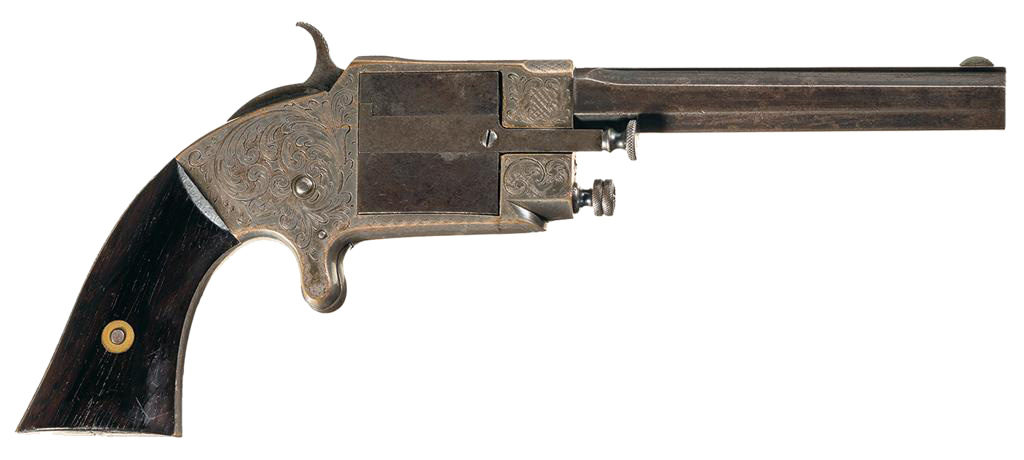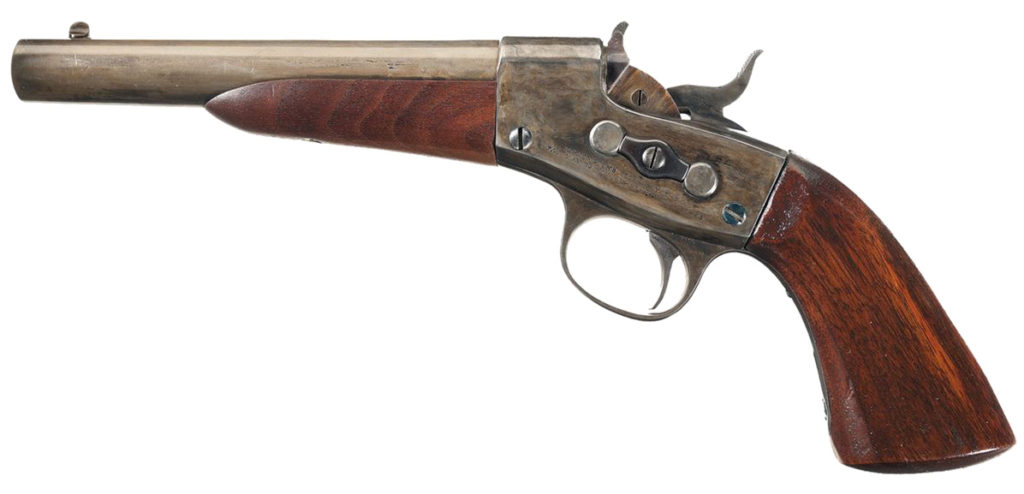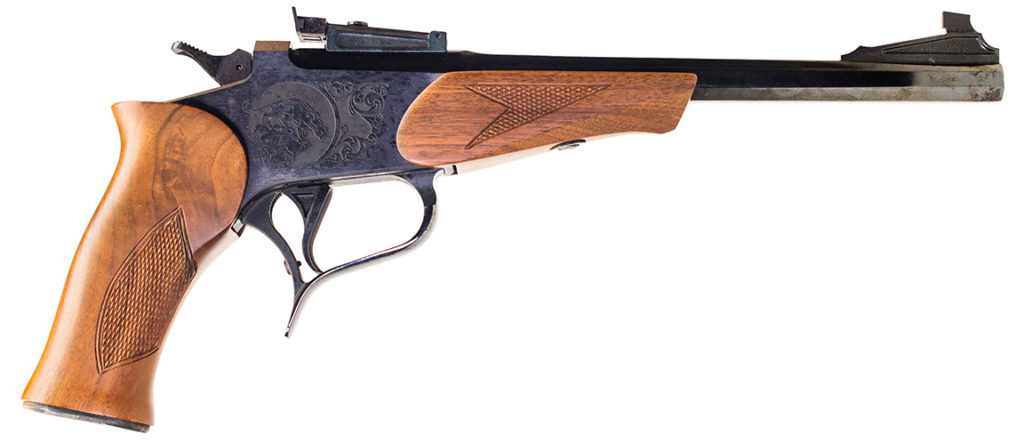Breech Pistols
- At August 05, 2017
- By Great Quail
- In Armory, Deadlands
 1
1
Handguns Part II. Breech-Loading Single-Shot Pistols
Breech-Loading
The mid-nineteenth century was a time of great innovation in the field of firearms. People began the century dueling with the same flintlock pistols as their fathers and grandfathers, and ended with a plethora of options including caplocks, single-shot breech-loaders, pepperbox pistols, revolvers, and the first magazine-fed semi-automatics. By the time breech-loading rifles began to supplant muzzle-loaders in the early 1860s, most handguns were already using some form of revolving cylinder. Still, a few breech-loading pistols made their way to the market, particular those designed by Frank Wesson, Joshua Stevens, and Remington. Like their larger cousins, such pistols require some form of mechanical action to open the breech, chamber the round, and reseal the breech. Because handguns do not require the same range and accuracy as rifles, creating an effective system of “obturation”—sealing the breech during discharge to prevent the escape of hot gas—is not as important to pistols as it is to rifles and carbines.
 Frank Wesson’s “tip-up” loading Frank Wesson’s “tip-up” loading |
 Rollin White’s “swivel down” loading Rollin White’s “swivel down” loading |
Cartridges
Another important mid-century innovation was the metal cartridge, in which the bullet, propellant, and primer are encased within the same unit. The round is discharged when the firing pin strikes the base of the cartridge, setting off the primer. Because metal expands when heating, the hot casing forms a gas seal, directing the explosive energy forward. Such cartridges, usually made from brass (and before the mid-1870s, copper) are designated as “rimfire” or “centerfire” depending on where the firing pin strikes the case. Of course, the spent casing must be extracted, an additional mechanical process that adds further complexity and invites potential malfunction.
Pocket Rifles
A fad that emerged simultaneously with breech-loading pistols is the “pocket rifle.” Pioneered by the Stevens Rifle Company of New York, a pocket rifle is a larger version of a company’s standard pistol, equipped with a longer barrel and a detachable shoulder stock, usually a light framework known as a “skeleton” stock. Cheaper than traditional rifles and more portable, they had a shorter range, and usually suffered from poor obturation. In the 1880s, they began selling as “bicycle rifles,” linking them to another popular nineteenth-century fad. Like the buggy guns of previous years, pocket rifles were meant for recreation—shooting at birds and “varmints,” impressing girlfriends with feats of marksmanship, or just “plinking” away to pass the time.
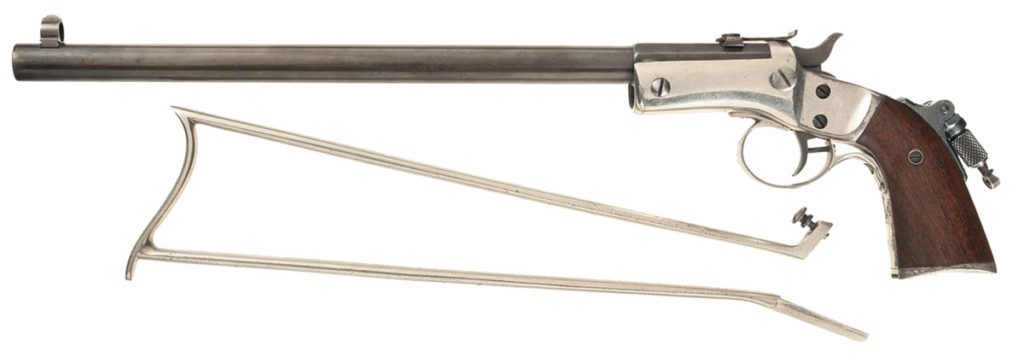 Stevens New Model Pocket Rifle No. 40
Stevens New Model Pocket Rifle No. 40
The Armory: Breech-Loading Pistols, Chapter 1. General Categories
Break-Action Flintlock
1600–1840s, breech-loading flintlock. Caliber .50 to .69, Range 3/15/30, Capacity 1, Rate of Fire 1/2 to 1/3, DAM 2d10 to 2d12, Exceptionally rare. Notes: The Rate of Fire depends on the cartridge type; 1/2 if the pan is included, 1/3 for powder and shot only. On a roll of Natural 1, the priming powder fails to discharge and must be replaced before the pistol can be fired.
 German “break-action” pistol, mid-1700s
German “break-action” pistol, mid-1700s
The ancestor of the tip-up pistol, the break-action revolver, and the famed double-barrel shotgun, a “break-action” flintlock features a hinge that allows the user to swing the barrel downward to expose the bore. This hinge is activated by some form of locking latch, usually a lever or toggle integrated into the trigger guard. The shooter inserts a reusable steel cartridge into the breech and closes the action. Daring from the matchlock period and allegedly invented by Leonardo Da Vinci, these cartridges are preloaded with gunpowder and shot, and are carried in a case along with several ready replacements. Some gunmakers integrate an individual priming pan and frizzen into the cartridge. Essentially serving as detachable chambers, these cartridges lock in place neatly under the hammer. Expensive and difficult to produce, break-action flintlocks were never intended for the common shooter, and were primarily manufactured in England and Germany during the early to mid-eighteenth century.
 Pistol by Andrew Reinhold Dolep, c. 1690–1720
Pistol by Andrew Reinhold Dolep, c. 1690–1720
Queen Anne Pistol
1650–1780s, breech-loading flintlock. Caliber .50 to .69, Range 5/25/50, Capacity 1, Rate of Fire 1/3*, DAM 2d10 to 2d12, Uncommon. Notes: Characters with d10+ Agility may reduce the Rate of Fire to 1/2. On a roll of Natural 1, the priming powder fails to discharge and must be replaced before the pistol can be fired.
Known properly as a “turn-off” pistol, this ingenious form of flintlock became popular during the rule of Queen Anne, this bestowing its lasting nickname. In a turn-off pistol, the breech, lock, and trigger plate are forged as a single piece, anticipating a modern firearm’s action by over a century. The tapering barrel is detachable, screwed onto the chamber and locked using a key.
To load a turn-off pistol, the user unlocks and unscrews the barrel. Powder is placed into the exposed chamber, and the bullet is set into a small “cup.” The barrel is screwed back on and locked into place. Because the bullet is slightly larger than the actual bore, it’s held in place without the use of ramming or wadding. Fired by a standard flintlock mechanism, the exploding powder drives the ball from the cup and propels it through the barrel. This deforms the bullet, which creates its own gas seal. Many turn-off pistols have rifled barrels for increased accuracy.
Because a detachable barrel can be easily dropped in the heat of battle, turn-off flintlocks were never considered for military use, despite the attempt by some gunmakers to apply the principle to carbines. Costly to purchase, Queen Anne pistols were popular among the upper classes, and were often carried for the purpose of self-defense. Smaller versions were especially in vogue among the ladies. Known as “Toby guns,” they were commonly carried as “muff guns,” the ancestor of the nineteenth-century derringer.
Breech-Loading Caplock Pistol
1830s–1860s, breech-loading caplock. Caliber .50 to .54, Range 5/15/30 unrifled, 10/20/40 rifled, Capacity 1, Rate of Fire 1/2, DAM 2d10, Uncommon.
 The rotating breechblock of this pistol is opened by activating the lever under the barrel. The “owl” is a cocking device.
The rotating breechblock of this pistol is opened by activating the lever under the barrel. The “owl” is a cocking device.
A search through the annals of early nineteenth-century firearms reveals dozens of breech-loading caplock pistols, most produced before the Civil War and falling out of favor once revolvers became affordable. The majority of these designs open the breechblock by activating a lever, often integrated into the trigger-guard. When the shooter pulls the lever, the breechblock usually tilts up, drops down, or rotates aside. A paper cartridge is inserted into the chamber and the breech is closed by returning the lever. A few models employ a mechanical trapdoor in the top of the frame, but that method was more commonly used with rifles and carbines.
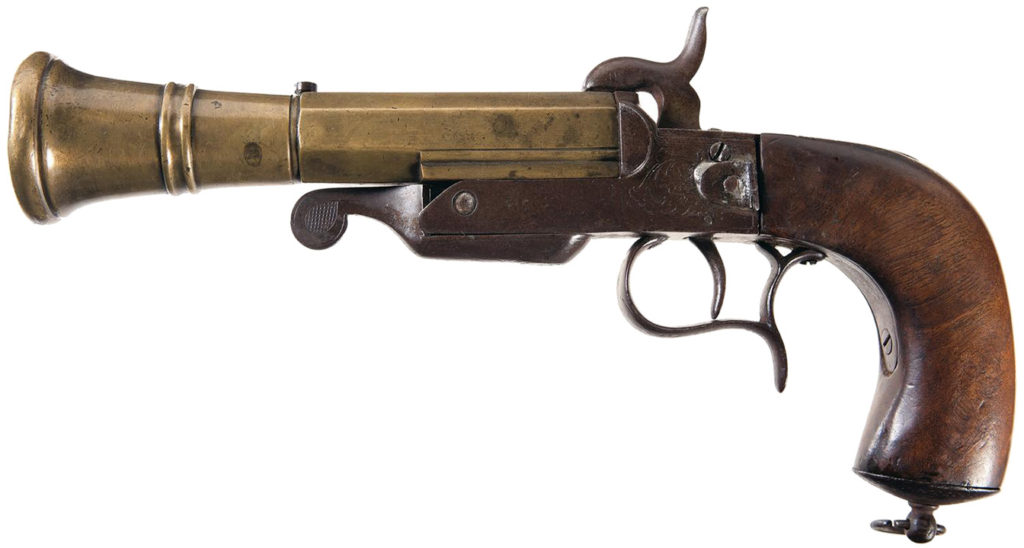 This .72 pinfire Belgian blunderbuss tips up when the lever is activated.
This .72 pinfire Belgian blunderbuss tips up when the lever is activated.
Players and Marshals wishing to resurrect some of these nineteenth-century antiquities are free to research historical models, with the above statistics offering a generic template. A few common American manufactures include H.C. Fay of Lancaster, Massachusetts; Lucius Gibbs of Oberlin, Ohio; Henry Harrington of Southbridge, Massachusetts; and Thomas McCarty of Elmira, New York. William W. Marston, Alonzo Perry, Christian Sharps, and Westley Richards are specifically profiled below in Chapter 2.
The Armory: Breech-Loading Pistols, Chapter 2. Specific Models
W.W. Marston Breech-Loading Single-Shot Pistol
1851–1856?, USA, breech-loading caplock. Caliber .36, Range 10/20/40, Capacity 1, Rate of Fire 1/2, DAM 2d6, Very rare.
Known primarily for his pepperbox pistols, William W. Marston of New York designed over a thousand single-shot pistols using the same patented breech-loading system he used for his rifles. When the loading lever is pulled, a bolt slides back to allow a specialized cartridge to be inserted through a loading gate in the right side of the breech. These Marston cartridges are made from blue-colored paperboard attached to a leather base. This leather disc serves as a rudimentary gas seal, and helps swab the bore when ejected from the barrel by the subsequent bullet.
William W. Marston’s pistols are quite handsome, and are frequently decorated with floral engravings or scroll designs. The loading lever is set flush with the grip, both curved around an open circular space for easy operation. The barrels are blued, and the grips are made from varnished walnut. Iron-framed Marstens sport a case-hardened finish, while the rarer brass pistols are often plated in silver.
Perry Breechloading Percussion Pistol
1854–1856, USA, breech-loading caplock. Caliber .52, Range 10/25/50, Capacity 1, Rate of Fire 1/2*, DAM 2d10, Very rare. Note: The automated capping system marginally increases the Rate of Fire. If a shooter draws a Joker or Ace during his “loading” round, he may fire at the end of that action round.
Designed by Newark gunsmith Alonzo Perry, this breechloading pistol features a blued steel frame with side-hammer, a round 7½” tapering barrel, and an acutely curved trigger-guard loading lever. Pulling down the lever tilts up the breechblock and exposes the chamber, which is loaded from the top using a paper cartridge.
Perry continued tinkering with his design, introducing the “Second Type” a year later. Featuring an elegant S-curve trigger-guard, the revised pistol is equipped with a patented automatic capping system. When the breechblock is opened, a mechanism automatically inserts a percussion cap onto the nipple. These caps are drawn from a spring-loaded tube running through the grip and accessed through a small port on the butt.
Chambered for .52 caliber, Perry’s pistol packs quite a wallop, but only a few hundred were manufactured. Perry also used the pistol mechanism for a line of cane pistols, and produced a few rifles and carbines as well.
Sharps Breech-Loading Single-Shot Pistol
1854–1857, USA, falling-block caplock. Caliber .31, .34, .36, Range 10/30/60, Capacity 1, Rate of Fire 1/2, DAM 1d4+1d6 to 2d6, Very rare.
While working with Robbins and Lawrence at the Sharps Rifle Company, Christian Sharps was eager to apply his patented falling-block action to pistols. His more market-savvy partners refused, and in 1854 Sharps left the company that bore his name to found a new workshop in Philadelphia: C. Sharps & Company. (A more detailed history of Christian Sharps may be found in the “Breech-Loading Rifles” section of the Armory.)
Sharps’ single-shot pistols use the same falling-block action as their larger cousins. To load a Sharps pistol, the shooter half-cocks the hammer, which frees a trigger-guard loading lever. Pulling down the lever lowers the breech, allowing the user to manually insert a cartridge from the top of the receiver. The shooter returns the lever to close the breech, an action that automatically primes the pistol from an integrated pellet primer. The hammer is fully cocked and the pistol is ready to be fired. Unfortunately, few customers proved willing to trade their revolvers for single-shot pistols, and only a thousand Sharps pistols were manufactured. (As Norm Flayderman points out, Sharps’ partners were correct in their assessment of the market!) Silver-plated Sharps Type II
Silver-plated Sharps Type II
The standard Sharps pistol features walnut grips, a case-hardened trigger and action, and a round barrel of blued steel. The Type I is chambered for .31 and .34 caliber, with the slightly-larger Type II fitted for .36 caliber. Sharps also made about 600 “pistol carbines” and “pistol rifles” in .31 and .38 caliber; they were basically elongated pistols equipped with a forestock and buttstock.
Frank Wesson Tip-Up Pistol
1856–1893, USA, tip-up. Caliber .22 to .44 rimfire, Range 10/20/40, Capacity 1, Rate of Fire 1/2, DAM 2d4 to 2d8, Rare. Notes: Given the many variations of this pistol, characters wishing to equip a Frank Wesson single-shot pistol should specify the model and caliber. These stats may also be used for Wesson’s competitors. Wesson pocket rifles are double the given range.
The three Wesson brothers of Massachusetts would each go on to earn fame in the firearms business. The eldest, Edwin Wesson, became a respected craftsman known for his superb muzzle-loading hunting rifles, while the middle son, Daniel, was the Wesson in “Smith & Wesson.” The youngest son was Frank, who combined Edwin’s skills as a craftsman with Daniel’s penchant for invention. After traveling to California to arm the miners during the ‘49 Gold Rush, Frank Wesson returned to Massachusetts and set up shop in Worcester, where he partnered with numerous other gunsmiths from 1859 to his death in 1899.
Frank Wesson made several types of handgun during his years in Worcester, but the most famous was his “tip-up” model. These guns feature a barrel that pivots down from the frame, “tipping up” the breech for loading when the release is toggled. They all have spur triggers, with square butts and rosewood grips being the standard. Generally chambered for .22 rimfire cartridges, Wesson’s tip-up guns are durable, easy to load, and primarily intended for target shooting. “Pocket rifle” variants feature extended barrels and detachable skeleton-type shoulder stocks.
Rollin White Single-Shot Pocket Pistol
1861–1864, USA, breech-loading. Caliber .32 and .38 rimfire, Range 10/20/40, Capacity 1, Rate of Fire 1/2, DAM 1d4+1d6 and 1d6+1d8, Rare, with the .38 being exceptionally rare.
In 1858, Rollin White received a patent for a simple breech-loading mechanism. By pulling a side-mounted lever, the shooter swivels the breech down from the right side of the frame to expose the chamber. A cartridge is loaded, and the breechblock is pushed back up into place. (This action is shown in the introduction above.) While hardly as revolutionary as his famous revolver cylinder patent of 1855, this action proved simple and reliable, and White put 3000 of his pistols into production at the Rollin White Arms Company in Lowell, Massachusetts.
Marketed as a pocket pistol, White’s single-shot rimfire was produced in two calibers: a .32 model with a 3” barrel, and the larger-framed .38 model with a 5” barrel. Both versions have octagonal barrels and spur triggers, but the .38 model is much rarer, with only 200-300 manufactured. White also varied the frames, alternating between a silver-plated brass frame and an iron frame with a blued finish.
W.H. Brown Pocket Rifle
1862, USA, breech-loading. Caliber .22 rimfire, Range 20/40/80, Capacity 1, Rate of Fire 1/2, DAM 2d4, Exceptionally rare.
Born in Edmeston, New York in 1819, William H. Brown settled in Worcester, Massachusetts and spend most of his life working in his machine shop, building shoemaking tools, carding machines, dividing engines, baseball-winding machines, portable showers, and an early typewriter based on Charles Thurber’s designs. At the beginning of the Civil War, Brown developed a single-shot buggy rifle chambered for the .22 rimfire cartridge. The gun is loaded by pulling down a trigger-guard loading lever, which slides the barrel forward to expose the breech. A rather elegant firearm with a nickeled-brass frame, the skeleton shoulder stock is decorated with ornate curls, and the loading lever ends in a brass ring.
A “confirmed bachelor” all his life, Brown was known as a modest and retiring man, and died in 1909 at the Home for Aged Men in Worcester. Fastidious and inventive to the last, Brown engineered his own funeral, from designing the brass castings to be used for his crematorium inscription, to creating handwritten letters to be delivered to his relatives informing them of his death! While his pocket rifle never achieved widespread popularity, its attractive curves and fascinating provenance make it a fine weapon for any discriminating Marshal to introduce into the Deadlands.
Westley Richards Pistol, “Monkey Tail”
1867–1869, UK/Portugal, breech-loading caplock. Caliber .451, Range 10/30/60, Capacity 1, Rate of Fire 1/2, DAM 2d10, Very rare.
In 1866 the Birmingham firm of Westley Richards received a substantial order from Portugal for nearly twelve thousand firearms equipped with Westley Richards’ patented “monkey-tail” breech-loading system. Among this order was a request for a thousand pistols, intended for use in Portuguese cavalry regiments. Although better known for their rifles, carbines, and shotguns, Westley Richards agreed, and in 1867 produced a caplock pistol using an abbreviated version of the monkey-tail system found on their carbines. (See the Deadlands Armory’s “Breech-Loading Rifles” page for a history of Westley Richards.)
The nickname is derived from the long breech-lever, which is recessed into the top of the frame behind the hammer. As long as the hammer remains uncocked, a protruding tab allows the lever to be lifted upwards, revealing a smooth groove leading into the open chamber. The shooter inserts a felt-based paper cartridge and lowers the “monkey tail,” an action which pushes the cartridge into the bore and seals the breech. The hammer is cocked and the nipple capped, and the pistol is ready for firing. As an additional safety measure to ensure the breech stays closed, the pressure from the exploding cartridge drives a piston backwards to mechanically lock the breech.
 Top view of breech and “monkey-tail” lever
Top view of breech and “monkey-tail” lever
The pistol itself is quite handsome, with a walnut frame, brass furnishings, and bright steel lockplate, hammer, breech and barrel. A lanyard ring is fixed to the butt, and the distinctive Westley Richards pyramid logo is prominently stamped on the lockplate. Only the pistols intended for the Queen’s Lancers featured a ramrod.
Stevens Tip-Up Pistols
1864–1916, USA, tip-up. Caliber .22 rimfire to .44 centerfire, Range 10/20/40, Capacity 1, Rate of Fire 1/2, DAM 2d4 to 2d8, Common. Notes: Given the many variations of this handgun, characters wishing to equip a Stevens pistol should specify the model and caliber.
 Stevens No. 41 Tip-Up Pocket Pistol with bone grips
Stevens No. 41 Tip-Up Pocket Pistol with bone grips
One of the more famous Civil War-era gunmakers was Joshua Stevens. Born in Chester, Massachusetts in 1814, Stevens was a toolmaker who had a knack for making improvements to other inventors’ patents. Becoming fascinated with guns under the employ of C.B. Allen of Springfield, Stevens worked on the Elgin cutlass pistol and on John Cochrane’s “turret” guns. Over the next decade, Stevens went on to work for Eli Whitney, Samuel Colt, Edwin Wesson, and finally the Massachusetts Arms Company of Chicopee Falls. During his tenure as Supervisor of Production, Stevens was awarded a patent for an improved tip-up mechanism. Purchasing a nearby grist mill, Stevens remodeled it as a gun shop, and in 1864 J. Stevens & Company opened its doors, inaugurating a run that would last until 1942.
During the remainder of the nineteenth century, Stevens produced dozens of varieties of single-shot pistols, from .22 rimfire derringers to the long-barreled Stevens-Conlin pistols of the 1880s. The majority of these were tip-ups, with Stevens favoring low-profile “mushroom” release buttons rather than Frank Wesson’s toggle. All of the early models had spur triggers, with standard triggers and trigger-guards first introduced in 1880.
 Stevens-Conlin First Issue Pistol, .22 rimfire, nickel-plated with walnut grips, 1880–1884
Stevens-Conlin First Issue Pistol, .22 rimfire, nickel-plated with walnut grips, 1880–1884
Remington Navy Rolling Block Pistol
1866–1870, USA, rolling block. Caliber .50 rimfire, Range 10/30/60, Capacity 1, Rate of Fire 1/2, DAM 2d10, Uncommon. Notes: When firing a Remington rolling block, the shooter adds a d4 die to his Shooting roll. This is not an extra wild die; but a critical failure only occurs if the shooter rolls three ones (his Shooting die, his wild die, and the extra d4).
The first handgun to use Remington’s “rolling block” breech-loading mechanism was the Navy Pistol of 1865. A rather hefty pistol, the Navy is loaded in the same manner as Remington’s rolling block rifles. (A detailed history of Remington is found in the “Breech-Loading Rifles” section of the Deadlands Armory.) After fully cocking the hammer, the shooter pulls down a tab mounted in front of the hammer, rolling the breechblock open and exposing the rear end of the barrel. This action also extracts a spent casing. A .50 caliber rimfire cartridge is inserted into the chamber, and the breechblock is rolled shut, enabling the pistol to be fired. The 1865 Navy pistol has an 8½” blued barrel, walnut grips, a case-hardened frame, and a distinctive spur trigger.
Two years later, Remington introduced the Model 1867 Navy. With a 7” barrel and standard trigger, it was otherwise similar to the Model 1865. Indeed, many new pistols were simply converted from the previous model.
Stevens Pocket Rifles, “Bicycle Rifles”
1869–1917, USA, tip-up. Caliber .22 rimfire to .44-40 centerfire, Range 20/40/80, Capacity 1, Rate of Fire 1/2, DAM 2d4 to 2d8, Uncommon. Notes: Given the many variations of the Stevens Pocket Rifle, characters wishing to equip a Stevens should specify the model and caliber. Range may be adjusted by length of barrel, caliber, and powder weight.
 Stevens Hunter’s Pet Pocket Rifle No. 34, 1872–1900
Stevens Hunter’s Pet Pocket Rifle No. 34, 1872–1900
In 1869, Stevens began converting their .22 Old Model Pocket Pistol into a pocket rifle by equipping it with a longer barrel and adding a detachable shoulder stock. This proved so successful that it was followed by several more models, generally classified by frame as light, medium, or heavy and chambered for calibers ranging from .22 rimfire to .44-40 centerfire.
 Stevens New Model Pocket Rifle, Second Issue, 1875–1896
Stevens New Model Pocket Rifle, Second Issue, 1875–1896
In 1876, the Stevens New Model Pocket Shotgun was introduced, popularly known as the “Taxidermist Model” on account of its light load. In the 1880s, the newly-christened J. Stevens Arms & Tool Company began marketing their pocket rifles as “bicycle rifles,” introducing a new term to the lexicon of firearms.
Remington 1871 Army Rolling Block Pistol
1872–1888, USA, rolling block. Caliber .50 rimfire, Range 10/40/80, Capacity 1, Rate of Fire 1/2, DAM 2d10, Uncommon. Notes: When firing a Remington rolling block, the shooter adds a d4 die to his Shooting roll. This is not an extra wild die; but a critical failure only occurs if the shooter rolls three ones (his Shooting die, his wild die, and the extra d4).
Continuing to improve the Model 1867 Navy pistol, Remington increased the barrel to 8 inches, made the grip more ergonomic, and replaced the rolling-block action with the updated version used in the Model 1871 rifles. Around five thousand of these pistols were sold to the U.S. government, while nearly a thousand more were sold for civilian use. Further iterations of the Remington pistol would include the Model 1891 and the Model 1901, both reduced in caliber and marketed as target pistols.
Model 1875 Rolling Block Pistol, “Centennial Pistol”
1875–present, USA, rolling block. Caliber .45 rimfire, Range 10/40/80, Capacity 1, Rate of Fire 1/2, DAM 2d8, Common.
As described in the “Breech-Loading Rifles” section of the Armory, in the world of Deadlands, Remington has emerged as the most popular firearms manufacturer in New York. In 1874, New York City asked Remington to produce a pistol based on the popular Union Blue Carbine. The result was the Model 1876 “Centennial,” which has the profile of the Model 1871 Army pistol but the case-hardened frame and brass trigger-guard of the Model 1874 “Gotham” carbine. While still overshadowed by revolvers, this single-shot pistol has become a favorite of sportsmen and target-shooters, and has sold over five thousand units alone at the Centennial Expo gun range in Central Park!
Locke & Valentine Bolt-Action Pistol No. 1, “Hesselius,” “White Hesselius”
1872–present, SCR, bolt-action. Caliber .32-30 Mondschein, Range 25/50/200, Capacity 1, Rate of Fire 1/2, DAM 2d8*, Rare. Notes: The increased damage is because of the Mondschein round. As a side effect of this specialized round, the Hesselius may harm supernatural beings normally immune to traditional weaponry. The Hesselius may also be loaded with traditional .32 rounds for standard damage.
In 1868, Austrian mining engineer Lutz von Becker left Sacramento to join the newly-established Second California Republic. Invited to Lynchburg by Maze inventor William Shakespeare Valentine, Von Becker began studying the application of azrucite alloys to the production of ammunition. Three years later, von Becker developed the “Mondschein” round, named after the German word for “moonlight.” A Mondschein round features a conical bullet made from a blend of lead and lunar steel; a mixture of iron, azrucite, and silver chemically treated with selenium salts and alloyed under blue flame. Able to hold an intensely bright polish, lunar steel is lighter and more flexible than traditional steel, but becomes brittle under sunlight and high temperatures, and frequently shatters into tiny slivers. Encased in a jacketed ghost-steel cartridge, each Mondschein round is backed by thirty grains of Lei Ming’s powerful Blue Powder No. 7. Leaving behind a bluish-silver streak as it discharges from the muzzle, a Mondschein round decomposes as it travels to its target, splintering upon impact into a series of freezing-cold fragments that radiate through the victim’s flesh. Although a Mondschein round lacks the penetrating force of a lead bullet, it combines the range of a traditional bullet with the impact damage of a shotgun.
Unfortunately, the unstable nature of Mondschein rounds prohibit their use in traditional firearms. In 1871, Valentine invited celebrated San Francisco inventor Adrian Locke to Lynchburg to help him create a pistol he dubbed the “Hesselius,” named after the occult detective from the works of Irish writer Sheridan LeFanu. The resulting pistol combines Locke’s penchant for bizarre curvature with Valentine’s appetite for expensive materials. The pistol’s rifled barrel is lathed from high-azrucite ghost steel shrouded by blued traditional steel, while the chamber, bolt, and bolt-handle are made from polished ghost steel. The Hesselius is extremely accurate, possessing a greater range than any handgun on the market; but like most of Valentine’s work, it remains prohibitively expensive. Although the pistol may be loaded with standard .32 centerfire cartridges, a serendipitous effect of von Becker’s rounds validates the pistol’s literary nickname. As a few surprised shooters have happily discovered, Mondschein rounds are able to inflict damage on supernatural beings! As a result, demand for the Hesselius has gradually increased since its release, with custom orders arriving from places such as New Orleans, Arkham, Mountaincrest, Mexico City, London, Yorkshire, Bucharest, and Cairo.
Locke & Valentine Bolt-Action Pistol No. 2, “Black Hesselius”
1874–present, SCR, bolt-action. Caliber .28-30 BPR, Range 25/50/200, Capacity 1, Rate of Fire 1/2, DAM 2d4+2, Rare. Note: Lacking the correct ghost-steel components, the Black Hesselius cannot be loaded with Mondschein rounds.
Shortly after finishing the Hesselius, Adrian Locke fell out with the narcissistic W.S. Valentine. Leaving Valentine Arms, Locke partnered with Augustus Bee Pluto to establish “Pluto & Locke” in late 1873. Lutz von Becker soon followed, and together Locke and von Becker created the Tartarus Gun, produced by Maze industrialist George Tibert and detailed in the “Revolving Rifles” section of the Deadlands Armory. Meanwhile, Valentine continued tinkering with the Hesselius. Recognizing that the exorbitant cost of lunar silver and ghost steel was hampering his potential sales, Valentine introduced the Lock & Valentine No. 2 “Black Hesselius” in 1874. Capitalizing on the range and accuracy of Locke’s original design, Valentine rechambered the pistol for a .28 caliber blue powder round, and elongated the barrel to maintain the pistol’s vaunted accuracy. Although the muzzle flash is quite fierce, the pistol remains powerful and accurate, and significantly less expensive than the newly-rechristened “White” Hesselius.
LeMat “Vacherie” Breech-Loading Single-Shot Pistol, “La panthère noir”
1875–present, CSA, break-action. Caliber .44-40 “Vacherie” BPR, Range 15/30/150, Capacity 1, Rate of Fire 1/2, DAM 2d6+2, Uncommon. Notes: Because of the diversity of the pistol’s exchangeable barrels, characters equipping the Vacherie should specify which barrel lengths and calibers they possess and keep track of appropriate statistics. It takes 4 action rounds to swap a barrel and adjust the firing pin accordingly.
A product of “Colonel” Jean Alexandre LeMat’s “Fabrique de Beaux Ouvrages,” the Vacherie Pistol is an elegant handgun designed to deliver a powerful round with a high degree of accuracy. Intended for sportsmen and target-shooters, the pistol was nicknamed “La panthère noir” after the “Colonel” used a prototype to kill a black panther while hunting in the bayou adjacent the Plantation.
Designed by Vacherie gunsmiths Ewball Toplady Oust and Warren Center, the Vacherie pistol is designed to be elegant and versatile. The fore-end may be quickly removed, which allows the shooter to swap out different barrels. Additionally, a selector screw on the hammer allows the shooter to switch between rimfire and a centerfire, or adopt a third “safety” position. Because each barrel contains its own sights and extractor, the shooter may select a different caliber and length by simply inserting the appropriate barrel into the frame and replacing the fore-end. The standard Vacherie pistol is equipped for the same .44-40 blue powder round used for the Vacherie LeMat revolver; but a shooter may purchase separate barrels for the .44-40 PCF round used by Palmetto repeaters, the Remington .50 rimfire cartridge produced by the Union, and the popular .38 blue powder round used in the Maze. There is also a 20-gauge shotgun barrel and a .22 “sporting” barrel.
Winchester Bolt-Action Pistol
1876–1919, USA, bolt action. Caliber .22, Range 10/25/80, Capacity 1, Rate of Fire 1/2, DAM 2d4, Very Rare.
 A .22 brass prototype based on the Winchester Model 1902 bolt-action rifle
A .22 brass prototype based on the Winchester Model 1902 bolt-action rifle
In 1876, Winchester decided to tentatively explore the handgun market, and began experimenting with single-shot, bolt-action pistols. Producing a few prototypes between 1876–1883, Winchester eventually declined to mass produce them. Some believe that Winchester and Colt had struck a “gentleman’s agreement” to stay out of each other’s markets; but even if this (probably apocryphal) story is true, both companies certainly continued to explore the possibility. Colt manufactured a few slide-action carbines at the end of the century, while in 1902, Winchester produced several prototype handguns based on their new .22 caliber bolt-action rifle.
 A .22 prototype based on the Winchester Model 1902 bolt-action rifle
A .22 prototype based on the Winchester Model 1902 bolt-action rifle
These Winchester pistols are offered here as a curiosity, as they were never mass-produced, and most modern collectors consider them “lunch bucket guns,” made by factory employees and not intended for a wider audience. In the world of Deadlands 1876, the Marshal should feel free to introduce a commercial Winchester pistol; but it would more likely come from the Palmetto Iron Works than New Haven.
Gage Pocket Rifle
1884–1900?, USA, breech-loading. Caliber .22 rimfire, Range 10/40/80, Capacity 1, Rate of Fire 1/2, DAM 2d4, Very rare.
Gunmaker James E. Gage learned his trade in Rochester, New York working for William Billinghurst. After moving to Ontario, New York, he received a patent for a breech-loading mechanism in which the breech swivels left to expose the chamber.
Moving to Concord, Gage used this patent to produce a limited run of buggy rifles chambered for .22 and .32 rimfire cartridges. Gage’s pocket rifle is available with a 15” or 20” barrel, and features a screwless, clamp-on shoulder stock. Admittedly a bit late in the game to compete with repeaters, revolvers, and even Stevens bicycle rifles, the Gage is offered here as a curiosity.
<< Rules | Innovations | Muzzle | Derringer | Pepperbox | Revolver >>
Sources & Notes
Books
To create this resource, I leaned heavily on Norm Flayderman’s Flayderman’s Guide to Antique American Firearms. Featuring photographs and detailed descriptions of thousands of antique firearms, this is an essential resource for any historical gaming campaign, and Flayderman’s Guide introduced me to several of the more bizarre weapons described in the Deadlands Armory. To flesh out some of the statistical details, I turned to John Walter’s Rifles of the World. I also recommend Dennis Adler’s Guns of the American West and David Miller’s Illustrated Book of Guns. Both feature historical notes and full-color illustrations of the West’s most iconic firearms, many of which are museum pieces photographed especially for these books.
Internet
Of course, the Internet was crucial for my research. The Web is filled with antique firearm collectors, and much of the information in the Armory was gathered from gun-ownership forums, antique auction sites, and the homepages of Civil War reenactors. Anyone interested in the historical firearms described in the Armory can find a wealth of additional information online, including videos of many of these guns being loaded and fired—sometimes by authentically-costumed reenactors! But without a doubt, the most useful resource on obscure firearms is Ian McCollum’s Forgotten Weapons. Perpetually cheerful and possessing a dry sense of humor, McCollum works in conjunction with auction houses to produce short videos spotlighting authentic antique firearms. McCollum explains their history, carefully reveals their inner workings, and sometimes takes them to the firing range. I also relied on Wikipedia, Antique Arms, and the Firearms History, Technology & Development blog.
Image Credits
Many of the photographs of firearms used in the Armory have been “borrowed” from online sources. Because most owners of vintage firearms are good-natured folk with a passion for promoting their hobby, I have no doubt they’ll be happy to see their photographs used to promote a wider understanding of antique weaponry. Having said that, if anyone is offended that I’m using an image without proper authorization, please contact me and I’ll remove it immediately. Many photographs depict modern reproductions, usually manufactured by Uberti, Pietta, Pedersoli, Cimarron, Taylor’s, or Dixie Gun Works. I favor these photographs because they make the gun look contemporary, something a Deadlands character might purchase in a gun store or pry from the cold, dead fingers of his enemy. When I could not find a shiny new replica, I usually turned to vintage gun auctions. The four best resources for detailed images of antique firearms are the Rock Island Auction Company, James D. Julia Auctioneers, College Hill Arsenal, and the Collectors Archives from Collectors Firearms, Inc. Thank you!
Fictional Guns
The Remington Model 1876 “Centennial” Rolling Block Pistol is an Uberti modernization of the Model 1891 Target pistol with 8” barrel. The Locke & Valentine “Hesselius” is based on the Remington XP-100, a futuristic-looking target pistol produced from 1963 to 1998 and based on Remington’s Model 40X bolt-action carbine. (I do love Remington!) If anything looks like a Maze-designed vampire hunter, this is it; just assume the gleam coming from the faux-wood nylon stock is actually highly-polished wood! The Vacherie Single-Shot Breech-Loading Pistol, “La panthère noir,” is based on the Thompson/Center Contender, introduced in 1967. The pistol has all of the features I describe, and was indeed designed by Warren Center, who I relocated to the nineteenth century—sorry, Warren!
Specific Online Sources
The following sites were invaluable in creating this resource: A page on the Stevens Pocket Rifle from the Online Museum for the Columbia Century Bicycle and the 1892 Chicago Expo, the fine post and detailed photographs of the Rollin White pistol at Civil War Talk, the entry on William H. Brown in the History of Worcester and Its People, published in 1919 by Charles Nutt, Robert Betteridge’s Westley Richards Monkey Tail History for The Roaring Forties, Chris Eger’s Remington XP100 Bolt-action Pistols: The Godfather of Hunting Handguns? for Guns.com, Joel J. Hutchcroft’s Review: Thompson/Center Contender Pistol in Shooting Times, Mike Venturino’s Winchester Handguns? from American Handgunner, and S.P. Fjestad’s Peculiar Pistol: The Winchester Bolt-Action Pistol from Guns & Ammo.
Author: A. Buell Ruch
Last Modified: 2018 June 28
Email: quail (at) shipwrecklibrary (dot) com
PDF Version: Deadlands Armory – Handguns 2. Breeech-Loading Pistols






